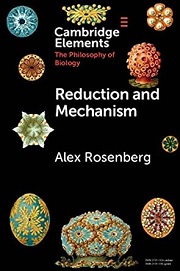Reduction and Mechanism

Alex Rosenberg
Cambridge University Press, £15.00
The Elements book series from Cambridge University Press provides an introduction to central ideas in the philosophy of biology. While some scientists are sceptical of the utility of philosophy of science to the practice of science itself, there is a strong case to be made for a greater dialogue between these disciplines. Rosenberg sets out early in the book to describe what he means by ‘reductionism’ as a metaphysical thesis – that the “physical facts fix all the facts”. As Rosenberg sees it “biological facts are fixed by physical and chemical ones”.
In addition to this metaphysical thesis, Rosenberg also envisages reductionism as a research programme where scientists seeking explanations about higher-level biological phenomena should look to discoveries in lower-level ones.
The book outlines some challenges to reductionism, including the problem of ‘multiple realisability’ – that similar functional outcomes in biology can be realised differently in physical terms. Rosenberg discusses the need for facts at one level, such as genes, to be ‘fixed’ by facts at a lower level, such as nucleic acids.
He moves toward reduction by observing that natural selection of adaptations and functional outcomes is “blind to differences in physical structure”, so that whatever similarities there are in functional outcomes will have been constrained by purely physical laws.
Rosenberg outlines how, in his view, the second law of thermodynamics is sufficient for natural selection to get started. Natural selection requires variation, reproduction and inheritance. If natural selection is blind to how any of these three criteria are achieved, then, for Rosenberg, it can get off the ground from ‘zero adaptation’ simply from the consequences of the second law of thermodynamics. Here I would have liked to have read more about the distinction between ontological reduction and epistemic reduction, which would have been helpful in an introductory text.
The position advanced in the book is at odds with ‘anti-reductionism’ – that is, that explanations about higher-level phenomena cannot necessarily be improved upon by appeals to lower-level processes. Rosenberg writes that such anti-reductionism is the “ruling view in the philosophy of biology”, and to his credit acknowledges that this is also the case in philosophy of mind and philosophy of psychology.
Given this state of affairs Rosenberg faces an uphill battle in convincing the reader against this prevailing tendency, especially in such a slim volume. It is, however, a very useful introduction to the debate concerning reductionism and anti-reductionism. While intended as introductory, I feel a reader attempting to get the most out of this would need some familiarity with core ideas in the philosophy of science generally.
Conor McCrory MRSB


